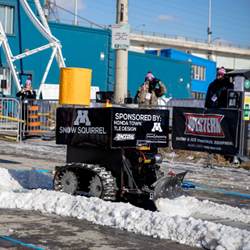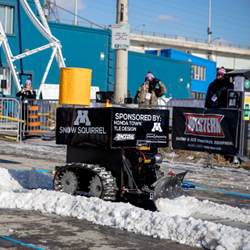
Over a weekend in late January, eight driverless vehicles faced off in a tournament in Toronto, Ontario. These weren't just another group of self-driving cars, however; they were autonomous snowplows.
The event was the ninth annual Institute of Navigation (ION) Autonomous Snowplow Competition. The competition began as a spinoff of a robotic lawnmower competition, also sponsored by ION, that was held from 2003 to 2010.
Changing it to a snowplow competition was the idea of Suneel Sheikh, CEO and chief research scientist at Advanced Space and Technology Research Laboratories (ASTER Labs), an aerospace research firm in Shoreview, MN.
"About 10 years ago," Sheikh recalls, "I was finishing up my Ph.D. in aerospace engineering at the University of Maryland, and my wife and I were moving back to the Twin Cities (Minneapolis/Saint Paul)." Sheikh was helping to start an ION chapter in the area and decided a student robotics competition would spark interest. He first considered autonomous snow blowers, but soon realized the potential danger of the blowers throwing rocks and other debris along with the snow. Snowplows seemed like a safer alternative.
In prior years, the snowplow competition was held during the Saint Paul Winter Carnival, but construction made that site unavailable this year. It looked as though the event might not happen at all, but "We got a call from Sidewalk Labs," Sheikh says. "Their parent company is Alphabet, which also owns Google, and they're assisting with the development of a significant portion of the waterfront in Toronto and changing it into a city of the future. They wanted to demonstrate how robots could augment everybody's lives."
Sidewalk offered its Toronto site, and the event was back on.
The competition was created with four specific goals in mind:
- Encourage the use of math and science to solve everyday problems, to help students see the value of these skills, and how they can be applied to practical engineering solutions.
- Advance the state of the art in vehicle navigation and control by selecting a sufficiently difficult and challenging real-world problem.
- Promote the capabilities and increase awareness of ION and its membership by demonstrating the uses of navigation-based technologies in real-world applications.
- Provide outreach to the public for the ION organization and its contributions to society.
The participants
The competition drew entries from student teams at six different institutions.
The Iowa State University Robotics Club entered the Cyplow, a skid steer robot with dual computer vision modules. North Dakota State University was represented by Thundar, another skid steer robot, with motors to control pitch and elevation of the plow and a LiDAR sensor for navigation. The University of Michigan—Dearborn's Yeti IX also used a LiDAR sensor, plus a camera for vision and obstacle detection. The Snow Squirrel from the University of Minnesota, Twin Cities, a compact track-driven plow, also used both LiDAR and a camera to map is surroundings.
Rounding out the field were two plows each from Case Western Reserve University in Cleveland, OH, and Dunwoody College of Technology in Minneapolis, MN.
"Case Western actually started with the 2007 DARPA Urban Challenge for autonomous cars," says Roger Quinn, a professor of mechanical and aerospace engineering at Case Western. "We had a big team, and we did fairly well." The next year, the team was approached by MTD Products, a manufacturer of outdoor power equipment, for help in designing an autonomous lawn mower. "And we said, 'sure'," says Quinn.
When the competition transitioned from lawn mowers to snowplows, "We took the lawn mower deck off the machine and put a snowplow on it," says Quinn. "We added weight for traction and sensors necessary when GPS is unavailable." That vehicle, formerly called the CRWU Cutter, is now named Otto von SnowMower and is the research project of Charles Hart, a Ph.D. student in computer science at Case Western, and lead software developer in research and development at MTD.
Case Western's other entry, named Snow Joke, came about through the efforts of another student, Marc Krumbein, to make a lower-cost version of an expensive part—a real-time I/O unit that cost about $1,000—that the team used in the DARPA competition."Otto is the research unit," says Hart. "Snow Joke strives for low-cost materials and comes in at about a quarter the cost of Otto."
Dunwoody College's two entries were called Wendigo 2019 and Snow Devils 10012. "Wendigo is a new plow that we built three years ago, while we've had Snow Devils for about seven years," says E.J. Daigle, Dunwoody's dean of robotics and manufacturing technology. "We take the students that are getting involved for the first time and put them on the Snow Devils team. The plow is pretty solid, and they can play around with the electronics and the programming. The veteran students are on the Wendigo team. Physically, Snow Devils is much smaller and is a two-wheel-drive platform, which means it can basically turn on a dime. Wendigo is a 1,200-pound four-wheel-drive beast."
The biggest differences between the plows, according to E.J. Daigle, Dunwoody's dean of robotics and manufacturing technology, lie in their navigation strategies. "Snow Devils is essentially a line-following robot," explains Daigle. "We have magnetic strips that we lay down next to the snowfield, and we run a very basic PID [proportional, integral, and differential] algorithm to determine if we're going to the left strip or the right strip. The Wendigo, in contrast, uses an attitude-heading reference system that combines gyroscopes and accelerometers and a whole bunch of sensor data. So the programming is much more advanced, looking at all this information and determining 'how fast am I going, what's happening with my heading, are my wheels slipping?' It gives you a lot more options on what to do and how to navigate, but it does require more than just a basic amount of programming knowledge."
The event
The day before the competition's two days of trials, the teams met with judges representing event sponsors, such as Western Products, which makes snow vehicles, and Honeywell, which makes a wide variety of control, navigation, and other systems. The participants had to demonstrate their vehicles were safe—they can't exceed speeds of two meters per second and must have both on-vehicle and remote emergency power-off switches. The judges also checked for compliance with rules cover the size of the vehicle, the approved plowing technologies (blades and brushes are okay, blowers are not), and so on.
During the competition, each autonomous plow was required to remove snow from two areas within a fixed amount of time: a straight, narrow path representing a sidewalk, and a wider path representing a driveway. In a third event, pairs of teams worked together to plow an S-shaped area.
Obstacles in the snowfields simulated hazards like parking meters and mailboxes. While navigational aids such as magnetic strips could be placed along the paths, the plows had to operate with no direct control during the trials.
The competition presented other challenges besides those built into the field of play. "When you turn the plow blade at an angle so you can push the snow to the side, it's like a big lever that could have five or six hundred pounds of snow pushing you the other way," says Daigle. "I won't mention any names, but one team had done a lot of practice inside without those forces, and you could tell that their PID algorithms were not tuned in properly. Instead of driving a straight line, they basically did this big sine-wave curve down the course."
The fact that snowplows must operate in the cold presents a challenge, too. "Teams will show up with a laptop computer, and they want to make programming changes at the starting line or in between runs," Daigle says. "However, when it's 10 degrees outside, some laptops—especially the ones that don't have solid state drives or aren't as robust—don't always work well. Everything's harder when it's 10 degrees outside."
That's true of the electronics in the plows themselves as well. "One year, we had to take our robot into a hotel in order to get it to turn on in the first place," recalls Hart. "Then we could bring it out to run the competition."
The results
The autonomous snowplows of Case Western and Dunwoody dominated the competition. Case Western's Snow Joke took first place on the narrow path, while Dunwoody's Wendigo came in second. On the wider path, Wendigo came in first, and Snow Joke was second. The University of Minnesota's Snow Squirrel team took the S-field crown (as it was the only plow able to complete that course in fully autonomous mode.)
Dunwoody also captured the Dr. Nattu Golden Smile Award for sportspersonship.
"As much as I'd call it a competition, it really is a collaboration as well," says Daigle. "Whether you get placed first or seventh didn't matter much as long as everybody's plow worked and every plow got a chance to push snow. We had a couple of teams that were struggling at the last minute and needed help, and there were other teams ignoring their own plow for the sake of making sure that all the other plows were working."
Jake Widman is a San Francisco, CA-based freelance writer focusing on connected devices and other Smart Home and Smart City technologies.




Join the Discussion (0)
Become a Member or Sign In to Post a Comment